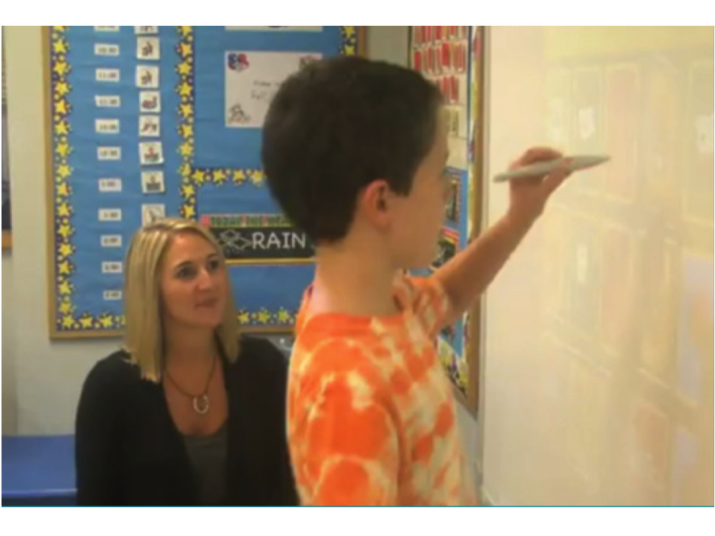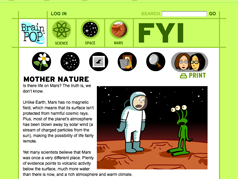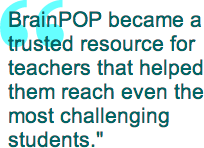Building Skill Mastery and Self-Confidence Through BrainPOP at School for Learning Disabled Students

The mission of Verona, NJ’s The Children’s Institute (TCI) has always been to provide the highest quality educational and therapeutic programs for students with learning, language and social/emotional challenges. When assistant Principal Gina Catania found herself looking for new ways to carry out that mission and help her students, ages 3 through 21, achieve their maximum potential as responsible adults, she turned to technology. She knew it was a great way to capture and maintain her students’ attention.
The Technology Champion
Computer specialist Randall Palmer chose BrainPOP® for TCI’s students because of its animation-based method of instruction.
“Most of our students are on the autism spectrum which means that they have strong visual processing skills,” he stated. “That’s one of the reasons the movies work well with our kids.”
 Palmer also noted that studies have found that autistic students are drawn to computer technology because of its predictable and consistent behavior, which they find reassuring.
Palmer also noted that studies have found that autistic students are drawn to computer technology because of its predictable and consistent behavior, which they find reassuring.
“BrainPOP is very straightforward and engaging; it follows the same sequence every time, and so students are comfortable with that. Our kids like the characters of Tim and Moby, and I really think they identify with Moby because his ability to communicate is limited. [Moby expresses himself strictly through beeps.]”
Palmer introduced TCI teachers to BrainPOP at a staff meeting. They found the program so intuitive that they began navigating through the various topic areas mostly on their own, with very little training.
Implementing BrainPOP to Engage Students in Learning
From October 2010 through April 2011, 15 TCI teachers across the K–12 grade range participated in a BrainPOP usage study. Every month, they used BrainPOP with two goals in mind: for students to learn topic-appropriate facts and terms and develop basic knowledge; and to increase student engagement. During the usage study, teachers integrated BrainPOP with a variety of subject areas — including Mathematics, Science, Social Studies, English, Engineering & Tech, Health, Arts & Music — and as they taught social skills.
TCI teachers used BrainPOP in three basic ways:
- To introduce a topic
- To reinforce a topic
- To review a topic
The teachers used BrainPOP primarily in whole-group settings, although it is also appropriate for individual and small group study. Whether using an interactive whiteboard or responding to questions with clickers (via classroom response system), students often raced to answer as though they were playing a game and would sometimes coach each other to get to the correct answer.
 BrainPOP’s pre-and post-assessments were integral to instructional plans, and they enabled teachers to get a reliable gauge of each student’s learning. If additional review was necessary, students could repeat the movie as often as they needed and complete the related activities until they finally achieved understanding.
BrainPOP’s pre-and post-assessments were integral to instructional plans, and they enabled teachers to get a reliable gauge of each student’s learning. If additional review was necessary, students could repeat the movie as often as they needed and complete the related activities until they finally achieved understanding.
All of the teachers in the study noted that students loved the character Moby. They responded to BrainPOP’s graphics and appreciated its sense of humor. Because they found Moby funny, students remained engaged even when the topics were abstract or called on higher-order thinking skills. Several teachers reported that BrainPOP was a fun way for their students to learn, and they often observed students retelling the movies’ jokes to each other.
Risa Wasserman, a Science and Social Studies teacher, noticed that even her shyest students became more engaged when the class focused on a BrainPOP activity.
“It’s like a light bulb comes on and they want to be at the board and at least try to give an answer. They might not always give the correct answer but you can almost see their thought processes,” she said. “I think the visual examples help them to be more successful and gain self-confidence.”
Wasserman also observed that the repetition of key points in the movies was an important contributor to her students’ skill mastery with BrainPOP.
Math teacher Jacqueline Smith said that in her classroom, students were definitely more willing to participate in the quizzes because BrainPOP was paced just fast enough to sustain their attention. Students could easily follow the topics as they were presented and did not find them as confusing as when they used a textbook. Smith noted that as a result of using BrainPOP her students gained a sense of accomplishment that made them more eager to learn.
 “I can definitely say that when I let them know that we’re going to start an activity using BrainPOP, they’re all engaged and excited about it.”
“I can definitely say that when I let them know that we’re going to start an activity using BrainPOP, they’re all engaged and excited about it.”
English teacher Sheryl Cahilig noted how much she liked using the “Related Reading” (high-interest readings) section to expand on the topic at hand, and the graphic organizers that focused on the most important ideas.
“I use BrainPOP Jr. for my lower functioning students,” she said. “My students really benefit from the visual aspect. Using BrainPOP’s closed captioning is helpful for those students who benefit from the additional learning modality and can read the words along with the movie.”
Reported Outcomes
As TCI teachers evaluated their use of BrainPOP at the end of each month of the study, it was clear that they felt their goals had been achieved:
- Each month, all or most of the teachers reported that students were more engaged when using the resource.
- Each month, most of the teachers reported that students learned more facts and terms and increased their basic knowledge.
- Each month, several teachers indicated that students developed deeper understanding of concepts, which they attributed to use of BrainPOP.
- Most months, most of the teachers felt that their students were more motivated or had improved their attitude toward their school subject(s).

Many of the teachers commented that using BrainPOP was both educational and enjoyable and that students often chose it as a free time activity. Through anecdotal reports from parents, teachers learned that students were also accessing the web sites from home. This meant that students were reinforcing their newfound learning and/or exploring new topics.
One of the most surprising benefits across the school was the significant decrease in behavior problems when teachers used BrainPOP with their classes. Teachers directly attributed this to the students’ sustained engagement in those lessons.
 Assistant Principal Catania observed that teachers’ confidence also increased during the study. They knew that when they used BrainPOP, it was going to motivate their students and contribute to a successful lesson. In fact, its use allowed TCI teachers to reach some students who had previously found learning very difficult. BrainPOP became a trusted resource for teachers that helped them reach even the most challenging students.
Assistant Principal Catania observed that teachers’ confidence also increased during the study. They knew that when they used BrainPOP, it was going to motivate their students and contribute to a successful lesson. In fact, its use allowed TCI teachers to reach some students who had previously found learning very difficult. BrainPOP became a trusted resource for teachers that helped them reach even the most challenging students.
“We’ve had teachers dress up as Moby for Halloween,” Catania said. “It’s made that big of an impact on our school. The students feel a sense of friendship with Moby, so they enjoy anything related to BrainPOP.”
The most important outcomes of the seven-month study were a result of BrainPOP’s engaging pattern of instruction. Students knew they would watch an animated movie, then answer questions and take a quiz.
In summing up their experience at TCI, Catania concluded, “BrainPOP’s movies, with their characters, sense of humor and games, were able to sustain the attention of our students long enough for real learning to take place. And that was our primary goal.”











